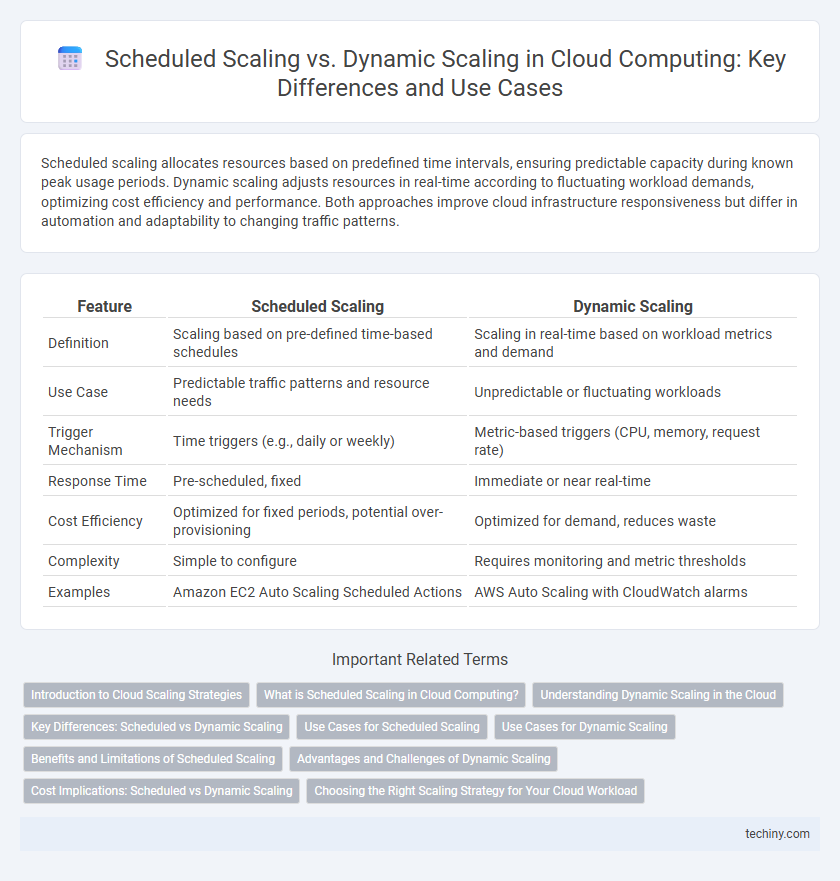Scheduled scaling allocates resources based on predefined time intervals, ensuring predictable capacity during known peak usage periods. Dynamic scaling adjusts resources in real-time according to fluctuating workload demands, optimizing cost efficiency and performance. Both approaches improve cloud infrastructure responsiveness but differ in automation and adaptability to changing traffic patterns.
Table of Comparison
| Feature | Scheduled Scaling | Dynamic Scaling |
|---|---|---|
| Definition | Scaling based on pre-defined time-based schedules | Scaling in real-time based on workload metrics and demand |
| Use Case | Predictable traffic patterns and resource needs | Unpredictable or fluctuating workloads |
| Trigger Mechanism | Time triggers (e.g., daily or weekly) | Metric-based triggers (CPU, memory, request rate) |
| Response Time | Pre-scheduled, fixed | Immediate or near real-time |
| Cost Efficiency | Optimized for fixed periods, potential over-provisioning | Optimized for demand, reduces waste |
| Complexity | Simple to configure | Requires monitoring and metric thresholds |
| Examples | Amazon EC2 Auto Scaling Scheduled Actions | AWS Auto Scaling with CloudWatch alarms |
Introduction to Cloud Scaling Strategies
Cloud scaling strategies include scheduled scaling, which allocates resources based on predictable demand patterns, and dynamic scaling, which adjusts resources in real-time according to actual workload fluctuations. Scheduled scaling enhances cost efficiency by provisioning capacity during known peak periods, while dynamic scaling maximizes performance and availability through continuous resource optimization. Choosing the right scaling approach depends on application requirements, workload variability, and cost management objectives within cloud environments.
What is Scheduled Scaling in Cloud Computing?
Scheduled scaling in cloud computing involves predefining specific times to increase or decrease computing resources based on predictable workload patterns. This approach enables organizations to optimize resource allocation and cost by aligning capacity with anticipated demand during known periods, such as business hours or seasonal spikes. Scheduled scaling is particularly effective for environments with consistent, time-based usage fluctuations, ensuring efficient performance without manual intervention.
Understanding Dynamic Scaling in the Cloud
Dynamic scaling in cloud computing automatically adjusts resources in real-time based on current demand, optimizing performance and cost-efficiency. Unlike scheduled scaling, which relies on predefined time windows, dynamic scaling leverages metrics such as CPU usage, memory load, and network traffic to trigger instant resource allocation or deallocation. This elasticity ensures applications maintain optimal responsiveness and availability during fluctuating workloads.
Key Differences: Scheduled vs Dynamic Scaling
Scheduled scaling operates based on predefined timeframes or predictable workload patterns, enabling resources to be adjusted ahead of demand spikes. Dynamic scaling automatically responds in real-time to fluctuating workloads by monitoring metrics such as CPU usage or network traffic, ensuring optimal resource allocation without manual intervention. Key differences include the reliance on predefined schedules in scheduled scaling versus the reactive, metric-driven adjustments characteristic of dynamic scaling.
Use Cases for Scheduled Scaling
Scheduled scaling is ideal for predictable workloads with consistent traffic patterns, such as daily batch processing or recurring marketing campaigns, where resource demands can be anticipated in advance. Businesses running e-commerce platforms often use scheduled scaling to prepare for peak shopping hours, ensuring sufficient capacity without over-provisioning during off-peak times. This approach minimizes costs by automatically adjusting cloud resources based on predefined schedules aligned with historical usage data.
Use Cases for Dynamic Scaling
Dynamic scaling excels in handling unpredictable workloads by automatically adjusting resources in real-time, ideal for e-commerce platforms during flash sales or media streaming services experiencing sudden viewership spikes. It ensures optimal performance and cost-efficiency by scaling up or down based on immediate demand without manual intervention. This adaptability supports applications with fluctuating traffic patterns, such as social media networks and online gaming environments.
Benefits and Limitations of Scheduled Scaling
Scheduled scaling enables precise resource allocation by increasing or decreasing cloud capacity based on predefined time intervals, improving cost efficiency during predictable workloads. This method benefits businesses with consistent traffic patterns but lacks responsiveness to unexpected demand spikes, potentially leading to performance bottlenecks. Limitations include its inflexibility and reliance on accurate forecasting, making it less suitable for highly variable or unpredictable application traffic.
Advantages and Challenges of Dynamic Scaling
Dynamic scaling in cloud computing offers the advantage of automatically adjusting resources in real-time based on current workload demands, leading to optimized cost-efficiency and improved application performance. It enables fine-grained resource management, reducing downtime and enhancing user experience during traffic spikes. Challenges include the complexity of accurately predicting workload patterns, potential latency in scaling decisions, and the need for sophisticated monitoring and automation tools to prevent resource over-provisioning or under-provisioning.
Cost Implications: Scheduled vs Dynamic Scaling
Scheduled scaling enables organizations to predefine resource allocation based on anticipated workloads, often resulting in cost savings by avoiding over-provisioning during predictable traffic patterns. Dynamic scaling automatically adjusts resources in real-time according to demand, which can prevent costly under-provisioning but may lead to higher expenses if usage spikes are frequent or rapid. Understanding workload variability and traffic predictability is essential for optimizing cost efficiency between scheduled and dynamic scaling strategies in cloud computing environments.
Choosing the Right Scaling Strategy for Your Cloud Workload
Scheduled scaling allocates cloud resources based on predefined time intervals, ensuring predictable capacity during peak usage hours, ideal for workloads with consistent demand patterns. Dynamic scaling adjusts resources automatically in response to real-time metrics like CPU usage or request rates, optimizing cost-efficiency for variable or unpredictable workloads. Selecting the right scaling strategy depends on workload characteristics, cost constraints, and performance requirements, with many organizations leveraging hybrid approaches to balance reliability and efficiency.
Scheduled Scaling vs Dynamic Scaling Infographic

 techiny.com
techiny.com